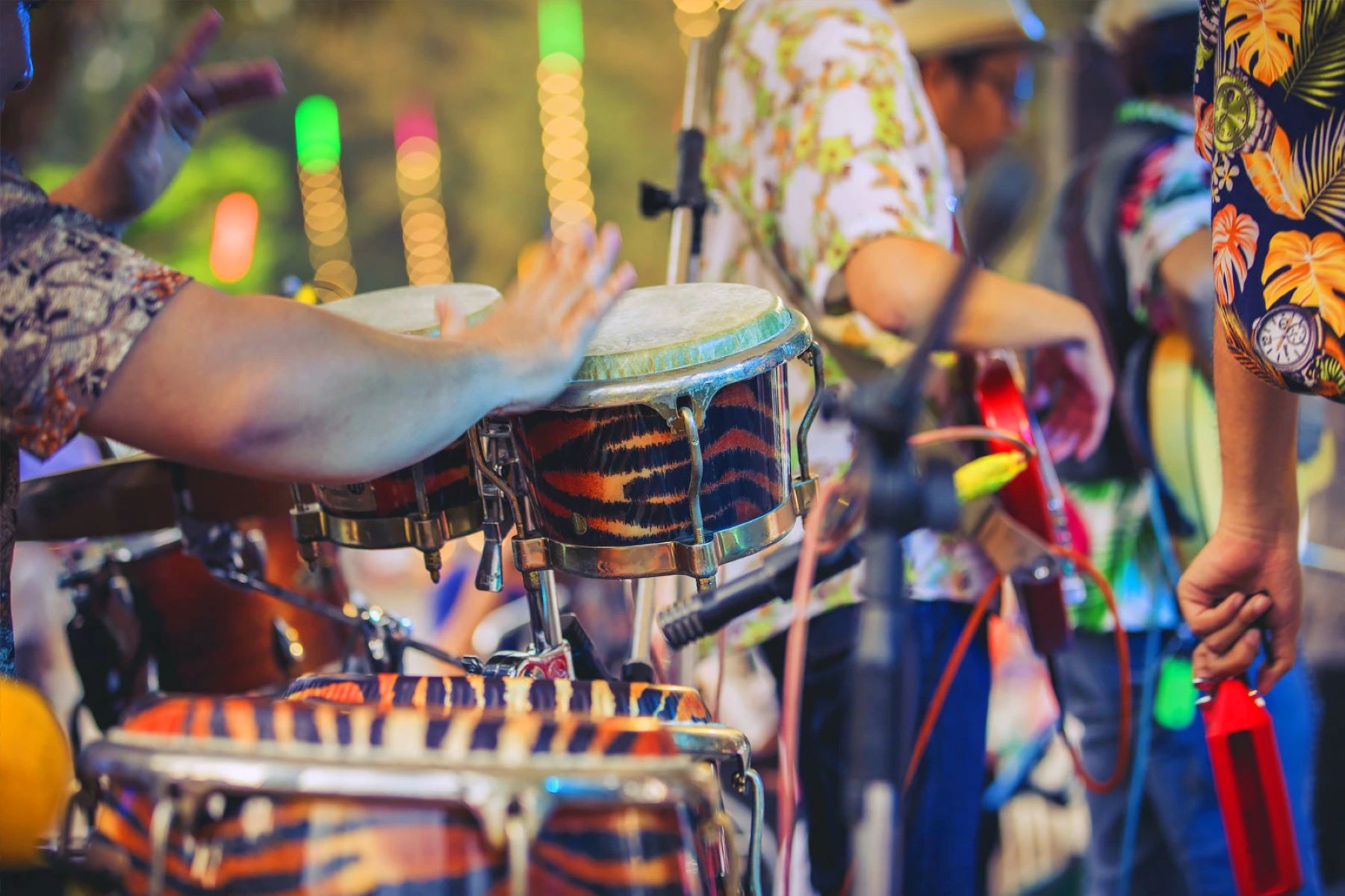

Hip Hop
Why Is Hip Hop The Best Genre Of Music
Modified: January 22, 2024
Discover why Hip Hop is the ultimate genre of music, featuring dynamic beats, powerful lyrics, and a vibrant culture. Embrace the rhythmic energy and creative storytelling that makes Hip Hop truly unmatched.
(Many of the links in this article redirect to a specific reviewed product. Your purchase of these products through affiliate links helps to generate commission for AudioLover.com, at no extra cost. Learn more)
Table of Contents
Introduction
Hip Hop, the dynamic and vibrant genre of music, has captivated the hearts and minds of millions around the world. From its humble beginnings in the streets of the Bronx, New York, to its global domination, Hip Hop has transcended boundaries and resonated with people from all walks of life. With its rich history, cultural influence, and unique features, Hip Hop has established itself as the best genre of music.
Emerging in the 1970s, Hip Hop was born out of the African American and Latino communities in the Bronx. It was a form of expression, giving voice to the voiceless and shining a light on the struggles and triumphs of urban life. Through its evolution, Hip Hop has become a powerful mode of artistic expression, encompassing elements of rap, DJing, breakdancing, and graffiti art.
What sets Hip Hop apart from other genres is its ability to convey raw emotions and tell compelling stories. The lyrics, often delivered with intricate wordplay and poetic prowess, explore a wide range of themes – from social issues and personal struggles to empowerment and celebration. Hip Hop has the power to evoke strong emotions, make you think, and move your body.
Another defining characteristic of Hip Hop is its ability to bridge cultural gaps and bring people together. It has become a global language, transcending barriers of race, nationality, and language. Whether you’re from the streets of New York, the favelas of Brazil, or the suburbs of Tokyo, you can connect with the beats, the lyrics, and the energy of Hip Hop.
Moreover, Hip Hop has been a driving force in shaping popular culture. It has influenced fashion trends, inspired dance styles, and impacted the way we speak. The impact of Hip Hop extends beyond music, permeating through various forms of media and entertainment.
Overall, Hip Hop’s power lies in its ability to reflect the realities of life, challenge societal norms, and bring people together. Its influence and reach have made it the best genre of music, capturing the hearts of millions and serving as a catalyst for change.
Evolution of Hip Hop
The evolution of Hip Hop can be traced back to the early 1970s when DJ Kool Herc, considered the father of Hip Hop, pioneered the practice of using two turntables to extend the instrumental breaks in songs. This technique, known as “breakbeat,” laid the foundation for what would become the backbone of Hip Hop music.
As the movement gained momentum, artists began to incorporate MCing (rapping) into their performances, delivering rhythmic and lyrical verses over the beats. Grandmaster Flash, Afrika Bambaataa, and The Sugarhill Gang were among the early pioneers who helped popularize Hip Hop music and culture.
In the 1980s, Hip Hop experienced a surge in popularity with the emergence of new artists and the release of groundbreaking albums. Artists like Run-D.M.C., LL Cool J, and Public Enemy brought a new level of sophistication and lyrical depth to the genre, exploring social and political commentary in their music.
The 1990s saw an explosion of creativity and innovation in Hip Hop. The East Coast-West Coast rivalry between artists like Notorious B.I.G. and Tupac Shakur captured the attention of the world. Meanwhile, artists like Nas, Wu-Tang Clan, and OutKast pushed the boundaries of lyricism and storytelling, elevating Hip Hop to new heights.
In the 2000s and beyond, Hip Hop continued to evolve and diversify. The rise of subgenres like trap, mumble rap, and alternative Hip Hop brought new sounds and styles to the forefront. Artists like Kendrick Lamar, J. Cole, and Drake infused introspective and thought-provoking lyrics into their music, further expanding the possibilities of Hip Hop.
Today, Hip Hop has become a global phenomenon, with artists from all corners of the world embracing the genre and infusing their own cultural flavors into the music. The genre’s evolution has been marked by innovation, experimentation, and constant reinvention, ensuring its relevance and longevity.
From its humble beginnings in the Bronx to its widespread influence around the globe, the evolution of Hip Hop is a testament to its enduring power and significance in the music industry. It has not only provided a platform for artists to express themselves but has also shaped the cultural landscape and inspired generations of musicians and fans.
Cultural Influence of Hip Hop
Hip Hop has had a profound cultural influence that extends far beyond the realms of music. It has become a movement that reflects the experiences, struggles, and aspirations of marginalized communities. Through its powerful storytelling and expressive art forms, Hip Hop has given voice to those who have been marginalized and silenced by society.
One of the key cultural impacts of Hip Hop is its role in empowering and giving a platform to underrepresented voices. The genre has provided a means for artists to share their stories, express their frustrations, and challenge the status quo. From addressing socio-political issues to recounting personal experiences of adversity, Hip Hop has become a vehicle for social commentary and activism.
Furthermore, Hip Hop has played a vital role in shaping urban fashion and style trends. The influence of hip hop fashion can be seen in streetwear, from baggy pants and sneakers to oversized hoodies and graphic tees. The culture of “bling” and the prominence of jewelry and accessories have become synonymous with Hip Hop style.
In addition, Hip Hop has also made a significant impact on the language and vernacular used by younger generations. Many words and phrases originated in Hip Hop lyrics and have become part of mainstream popular culture. This linguistic influence can be heard in everyday conversations and seen in social media posts.
Another cultural influence of Hip Hop is its impact on dance and movement. From breakdancing to intricate choreography, Hip Hop has introduced unique and innovative dance styles to the world. Dance has become an integral part of Hip Hop culture, allowing individuals to express themselves physically and artistically.
Moreover, Hip Hop has fostered a sense of community and created spaces for expression and collaboration. From block parties and open-mic events to rap battles and cyphers, Hip Hop gatherings bring people together, fostering a sense of belonging and camaraderie.
Overall, the cultural influence of Hip Hop cannot be overstated. It has shaped art, fashion, language, and dance, while also providing a platform for marginalized communities to share their stories and push for social change. Hip Hop’s impact reaches beyond music, transforming and empowering the lives of countless individuals worldwide.
Unique Features of Hip Hop
Hip Hop is a genre of music that stands out for its distinct characteristics and innovative elements. These unique features have contributed to its enduring popularity and success. Here are some of the key elements that make Hip Hop stand apart:
1. Rhythm and Beats: Hip Hop is driven by infectious beats and rhythmic patterns that form the foundation of its music. The pulsating drum patterns, catchy basslines, and use of samples create a captivating and head-nodding experience for listeners.
2. MCing and Rap: Central to Hip Hop is the art of MCing, also known as rapping. The skillful delivery of lyrics over the beats, often with complex rhyme schemes and wordplay, showcases the unique and expressive storytelling aspect of Hip Hop.
3. DJing and Turntablism: DJs play a crucial role in Hip Hop culture, using turntables and mixers to create seamless transitions, scratches, and remixes. Turntablism, the art of manipulating vinyl records, adds a dynamic and improvisational aspect to Hip Hop performances.
4. Sampling: Sampling is a fundamental technique in Hip Hop production, where existing sound recordings are incorporated into a new composition. This practice allows producers to create unique and creative arrangements by layering snippets of pre-recorded music.
5. Graffiti Art: Hip Hop is not just limited to music but extends into visual art forms such as graffiti. Graffiti art, with its vibrant colors and intricate designs, has become an integral part of the Hip Hop aesthetic, adorning walls and public spaces around the world.
6. Freestyle and Battle Rap: Freestyle rap, where artists improvise lyrics on the spot, and battle rap, where MCs engage in lyrical competitions, are integral components of Hip Hop culture. These high-energy showcases highlight the improvisational skills and lyrical dexterity of artists.
7. Collaborative Spirit: Hip Hop thrives on collaboration, with artists coming together to create joint albums, feature on each other’s tracks, and engage in friendly competition. The collaborative nature of the genre fosters creativity and pushes artists to new heights.
8. Remix Culture: Remixing is deeply ingrained in Hip Hop, allowing artists to put their own spin on existing songs. Remixes often feature new verses, samples, or production elements, giving a fresh perspective to familiar tracks.
9. Storytelling and Social Commentary: Hip Hop has a rich tradition of storytelling, with artists delving into personal experiences, social issues, and cultural commentary. The lyrics become a powerful means of expressing emotions, sharing perspectives, and shedding light on societal struggles.
10. Live Performances: Hip Hop’s energy truly comes alive during live performances. The interaction between the artist and the audience, the call and response, and the intense stage presence make Hip Hop concerts an immersive and unforgettable experience.
These unique features collectively contribute to the appeal and longevity of Hip Hop. They showcase the genre’s ability to push boundaries, captivate audiences, and serve as a powerful tool for self-expression and cultural storytelling.
Versatility and Innovation in Hip Hop
Hip Hop is a genre that thrives on versatility and innovation, constantly pushing the boundaries of what is considered possible in music. This willingness to experiment and evolve has contributed significantly to its enduring popularity and influence. Here are some key aspects that highlight the versatility and innovation in Hip Hop:
1. Genre Blending: Hip Hop has a unique ability to blend and incorporate elements from various musical genres. Artists often draw inspiration from R&B, jazz, funk, rock, electronic, and world music, resulting in a diverse range of sounds and styles. This versatility allows for endless creative possibilities and opens doors to new audiences.
2. Fusion of Traditional and Contemporary: Hip Hop seamlessly merges traditional musical elements with modern production techniques. It embraces old-school samples, classic drum breaks, and soulful melodies, while also embracing cutting-edge technologies and innovative production methods. This fusion creates a fresh and dynamic sound that appeals to a wide range of listeners.
3. Experimentation with Production Techniques: Producers in Hip Hop are known for their innovation and experimentation. They constantly push the boundaries of traditional production techniques, incorporating unique sounds, unconventional sampling, and intricate layering to create a distinct sonic landscape. This courage to explore and take risks keeps the genre fresh and exciting.
4. Alternative Subgenres: Hip Hop has evolved to include alternative subgenres that defy traditional stereotypes. From conscious rap that focuses on social and political issues to trap music with its heavy bass and rapid-fire delivery, these subgenres showcase the range of artistic expression within Hip Hop.
5. Evolution of Flow and Delivery: The evolution of flow and delivery in Hip Hop has been a constant source of innovation. Artists experiment with different rhythmic patterns, cadences, and vocal techniques, creating their unique signature styles. This innovation ensures that Hip Hop is always evolving and evolving in terms of how lyrics are delivered.
6. Cultural Fusion: Hip Hop has a global reach and has incorporated influences from cultures around the world. Artists from different backgrounds infuse their traditional music and languages with Hip Hop elements, resulting in a rich tapestry of sounds and perspectives. This cultural fusion contributes to the genre’s versatility and helps to break down cultural barriers.
7. Visual Innovation: Beyond the music itself, Hip Hop has been at the forefront of visual innovation. From groundbreaking music videos that tell compelling stories to visually stunning live performances, artists constantly strive to push the boundaries of visual storytelling and engage audiences on a multi-sensory level.
8. Embracing New Technologies: Hip Hop artists have embraced advancements in technology, utilizing tools such as digital audio workstations, drum machines, and synthesizers to create new sounds and textures. This embrace of technology enables artists to continue pushing the boundaries of what is possible in Hip Hop production and performance.
By embracing versatility and innovation, Hip Hop continues to captivate audiences and remain a dominant force in the music industry. Its ability to adapt, grow, and push boundaries ensures its relevance and sets it apart as a genre that constantly reinvents itself.
Social Commentary in Hip Hop
One of the most powerful aspects of Hip Hop is its ability to serve as a platform for social commentary. From its inception, Hip Hop has been used as a vehicle to address social issues, shed light on systemic inequalities, and give a voice to marginalized communities. Artists within the genre have leveraged their lyrical prowess and storytelling abilities to spark conversations, raise awareness, and advocate for change. Here are some key points that highlight the social commentary in Hip Hop:
1. Tackling Systemic Injustices: Hip Hop has been instrumental in shedding light on societal injustices and exposing the realities faced by marginalized communities. Artists like N.W.A., Public Enemy, and Kendrick Lamar have fearlessly addressed topics such as police brutality, racial discrimination, poverty, and mass incarceration. Through their lyrics, they have become the vanguard of social activism within the music industry.
2. Giving Voice to the Voiceless: Hip Hop provides a platform for those who have been marginalized and unheard. Artists use their lyrics to tell stories of struggle, resilience, and hope, giving a voice to individuals facing social and economic challenges. By amplifying these stories, Hip Hop brings attention to the voices that have been silenced by society.
3. Challenging Cultural Norms: Hip Hop has long been a catalyst for challenging and redefining cultural norms. Artists challenge stereotypes, toxic masculinity, and gender inequality through their lyrics. They encourage dialogue about societal expectations, identity, and self-expression. Hip Hop empowers individuals to challenge the status quo and embrace their authenticity.
4. Highlighting Socio-economic Disparities: Hip Hop provides a platform to address socio-economic disparities and income inequality. Artists often share their own experiences growing up in impoverished neighborhoods, shedding light on the challenges faced by marginalized communities. By bringing attention to these issues, Hip Hop sparks conversations about access to resources, employment opportunities, and the cycle of poverty.
5. Political Activism: Hip Hop has a long history of political activism and engagement. Artists use their music to critique political systems, challenge political leaders, and advocate for social change. From Public Enemy’s “Fight the Power” to Childish Gambino’s “This Is America,” Hip Hop has become a powerful tool for challenging the status quo and fostering political awareness.
6. Conscious and Thought-Provoking Lyrics: Many Hip Hop artists incorporate conscious and thought-provoking lyrics into their music. They use their platform to educate and enlighten, encouraging listeners to think critically about societal issues. This approach not only engages audiences but also encourages them to become active participants in addressing social challenges.
7. Inspiring Activism and Community Engagement: Hip Hop has inspired activism and community engagement. Artists often collaborate with community organizations, support local initiatives, and use their influence to drive positive change. They encourage their listeners to get involved, take action, and make a difference in their communities.
Through social commentary, Hip Hop has the power to create awareness, inspire change, and promote social justice. It serves as a voice for the voiceless, challenging systems of oppression, and amplifying the experiences of marginalized communities. The social impact of Hip Hop extends far beyond the music, fostering dialogue, and inspiring individuals to take action.
Hip Hop’s Impact on Society
Hip Hop’s impact on society has been profound and far-reaching, extending beyond the realms of music. This influential genre has shaped culture, empowered communities, and transformed the way we view and interact with the world. Here are some key aspects that highlight Hip Hop’s impact on society:
1. Empowerment and Self-Expression: Hip Hop has served as a source of empowerment for marginalized communities. It has given individuals a platform to express their thoughts, share their stories, and assert their identities. Through Hip Hop, people from all walks of life are empowered to embrace their individuality and confidently share their voices.
2. Cultural Representation: Hip Hop has played a significant role in amplifying underrepresented cultures. It has given a voice to communities that have been historically marginalized, providing a platform to showcase their talents and narratives. Hip Hop has challenged mainstream narratives and expanded the cultural landscape, fostering a more inclusive and diverse society.
3. Youth Empowerment and Inspiration: Hip Hop is often hailed as a voice of the youth. It has been a source of inspiration and motivation for countless young individuals, providing them with an avenue to express themselves creatively and pursue their passions. Through Hip Hop, young people find inspiration and the belief that they can overcome adversities and achieve their goals.
4. Influence on Fashion and Style: Hip Hop’s influence on fashion and style cannot be ignored. Artists within the genre have been trendsetters, introducing unique and innovative fashion trends, from baggy clothes and sneakers to bling and streetwear. Hip Hop has reshaped mainstream fashion, breaking conventional norms, and celebrating individuality.
5. Breaking Down Barriers: Hip Hop has the power to break down social and cultural barriers. It acts as a bridge, connecting diverse communities and fostering understanding. Through collaborations and cultural exchange, Hip Hop showcases the commonalities between different cultures, promoting unity and dismantling stereotypes.
6. Educational and Socioeconomic Opportunities: Hip Hop has created opportunities for education and socioeconomic advancement. It has inspired the establishment of community organizations focused on empowering youth through Hip Hop music, dance, and education. These programs provide access to resources and mentorship, equipping individuals with skills to succeed in various fields.
7. Awareness of Social Issues: Hip Hop has been instrumental in raising awareness about social issues and injustices. Artists use their music to shine a light on topics such as racial inequality, police brutality, poverty, and systemic oppression. Hip Hop has sparked crucial conversations, challenging society to confront these issues and work towards positive change.
8. Entrepreneurship and Economic Growth: Hip Hop has created a pathway for entrepreneurship and economic growth. Artists have built successful careers beyond music, venturing into fashion, film, sports, and entrepreneurship. Additionally, Hip Hop contributes to the economy through album sales, concerts, merchandise, and the growth of ancillary industries.
In summary, Hip Hop’s impact on society is multidimensional and profound. It empowers individuals, gives voice to the marginalized, fosters cultural representation, and promotes understanding and unity. Through its influence on fashion, education, entrepreneurship, and awareness of social issues, Hip Hop continues to shape society and inspire positive change.
Commercial Success of Hip Hop
Hip Hop’s commercial success has been undeniable, with the genre becoming a dominant force in the music industry. From its humble beginnings in the Bronx to its global reach, Hip Hop has achieved unprecedented levels of popularity and commercial success. Here are key factors that contribute to the commercial success of Hip Hop:
1. Mainstream Acceptance: Over the years, Hip Hop has transitioned from being a niche genre to a mainstream powerhouse. Its unique beats, catchy hooks, and relatable lyrics have resonated with a wide audience, transcending cultural and demographic boundaries. This broader acceptance has led to increased exposure, radio airplay, and chart-topping hits.
2. Global Appeal: Hip Hop has a universal appeal that transcends geographical borders. Its catchy beats, energetic performances, and relatable storytelling have captivated audiences worldwide. Hip Hop’s ability to adapt and incorporate local sounds and languages has attracted fans from diverse cultural backgrounds, contributing to its global success.
3. Influence on Popular Culture: Hip Hop has had a profound impact on popular culture, influencing fashion, language, and lifestyle trends. Artists within the genre have become cultural icons, with their style and personas shaping mainstream fashion and setting trends. This influence has contributed to the commercial success of Hip Hop by expanding its reach beyond music into various industries.
4. Brand Partnerships and Endorsements: Hip Hop artists have established themselves as valuable brand ambassadors, partnering with major companies for endorsements and collaborations. From clothing lines and footwear to beverage brands and technology companies, Hip Hop has proven to be a lucrative marketing tool for businesses seeking to connect with the urban market.
5. Live Performances and Tours: Hip Hop’s commercial success is bolstered by energetic and captivating live performances. Artists often embark on highly successful concert tours, attracting large crowds and generating significant revenue. The combination of thrilling performances, stage production, and fan engagement creates an unforgettable experience that fans are willing to invest in.
6. Digital and Streaming Dominance: The rise of digital platforms and streaming services has played a significant role in the commercial success of Hip Hop. With their widespread accessibility and convenience, platforms like Spotify, Apple Music, and YouTube have provided a global platform for artists to reach a vast audience. Hip Hop’s dominance in streaming charts has translated into increased revenue and exposure.
7. Entrepreneurial Ventures: Hip Hop artists have diversified their revenue streams by venturing into various entrepreneurial ventures. From fashion lines and merchandise to record labels and media production, artists have monetized their brand beyond music sales. These ventures have contributed to the financial success and longevity of Hip Hop artists.
8. Music Licensing and Sync Deals: The popularity of Hip Hop has made it an attractive genre for licensing and synchronization deals in film, television, and advertising. Hip Hop tracks are often featured in movies, TV shows, commercials, and video games, generating additional revenue and exposure for artists.
The commercial success of Hip Hop is a testament to the genre’s creativity, appeal, and ability to connect with a wide audience. Its crossover appeal, influence on popular culture, and entrepreneurial ventures have solidified its position as a force to be reckoned with in the music industry.
Global Reach of Hip Hop
Hip Hop’s global reach is undeniable, as the genre has transcended cultural boundaries and gained immense popularity across the world. From its origins in the Bronx, New York, Hip Hop has evolved into a global phenomenon, leaving an indelible mark on music, fashion, and popular culture. Here are key factors that contribute to the global reach of Hip Hop:
1. Cultural Fusion and Adaptation: Hip Hop’s ability to fuse diverse musical influences and adapt to local cultures has contributed to its global appeal. Artists from different countries and regions have incorporated their own cultural elements into Hip Hop, infusing it with unique flavors and languages. This cultural fusion creates a sense of familiarity and connection, resonating with audiences around the world.
2. Language as a Barrier Breaker: Unlike other music genres, Hip Hop has managed to transcend language barriers. Artists from non-English speaking countries have found success by rapping in their native languages, offering a unique perspective to the Hip Hop landscape. This linguistic diversity has helped to expand the global audience and attract listeners who connect with the authenticity and storytelling of artists in their own language.
3. Digital and Social Media Platforms: The digital era has played a crucial role in spreading Hip Hop across the globe. Social media platforms such as YouTube, Instagram, and SoundCloud have provided a global stage for artists to showcase their talent and connect with fans directly. This online accessibility has made it easier for international artists to gain exposure and build a fanbase beyond their local scenes.
4. Influence on Popular Culture: Hip Hop’s influence on popular culture extends beyond music. Its impact is felt in fashion, dance, film, and even politics. From the streetwear fashion trends influenced by Hip Hop artists to the incorporation of Hip Hop dance styles in mainstream entertainment, the genre has permeated various aspects of global culture, making it accessible and relatable to diverse audiences.
5. International Collaborations: Hip Hop artists have embraced collaborations with artists from different countries and cultures, further expanding its global reach. International collaborations bring together diverse talents, blending styles, and creating cross-cultural connections. These collaborations showcase the universal language of Hip Hop and help to bridge cultural gaps.
6. Influence of Hip Hop Icons: Iconic Hip Hop artists have become global ambassadors for the genre, providing inspiration and influence to aspiring musicians and fans across continents. Their success and global recognition have played a significant role in popularizing and spreading Hip Hop to new audiences around the world. The global impact of artists like Jay-Z, Eminem, and Kanye West cannot be overstated.
7. Platform for Local Voices: Hip Hop has provided a platform for local artists to express their unique perspectives and shed light on social issues specific to their regions. This has resulted in a diverse tapestry of regional Hip Hop scenes with their own distinct sound and identity. This local representation builds a global appreciation for the art form and fosters a sense of authenticity.
8. Hip Hop as a Voice for the Marginalized: Hip Hop’s themes of empowerment, social justice, and giving voice to the marginalized have resonated with people facing similar experiences around the globe. It has become a source of inspiration and solidarity for individuals in disadvantaged communities, offering a sense of connection and hope.
The global reach of Hip Hop is a testament to its adaptability, inclusiveness, and ability to connect people across cultures. As the genre continues to evolve and expand its influence, its impact on the global music landscape and cultural exchange remains profound.
Conclusion
Hip Hop, with its rich history, cultural influence, and unique features, has firmly established itself as the best genre of music. From its humble beginnings in the Bronx to its global reach, Hip Hop has broken cultural and geographical boundaries, captivating audiences around the world. Its impact on society, both in terms of empowerment and social commentary, is undeniable.
The evolution of Hip Hop has been marked by versatility and innovation, constantly pushing the boundaries of what is possible in music. Artists within the genre have fearlessly tackled social issues, shed light on systemic injustices, and given a voice to the marginalized. Hip Hop’s cultural influence extends beyond music, shaping fashion trends, language, and popular culture.
Hip Hop’s commercial success is a testament to its widespread appeal, global reach, and entrepreneurial ventures. The genre’s ability to connect with diverse audiences, adapt to local cultures, and transcend language barriers has solidified its position as a dominant force in the music industry. Hip Hop’s influence knows no bounds, empowering individuals, inspiring change, and fostering unity.
In conclusion, Hip Hop’s cultural significance and artistic prowess make it the best genre of music. It has reshaped the music industry, challenged societal norms, and given a voice to those who have been marginalized. Hip Hop’s enduring popularity, global reach, and impact on societies around the world ensure its legacy as a dynamic and influential genre that will continue to shape the music and culture for generations to come.











